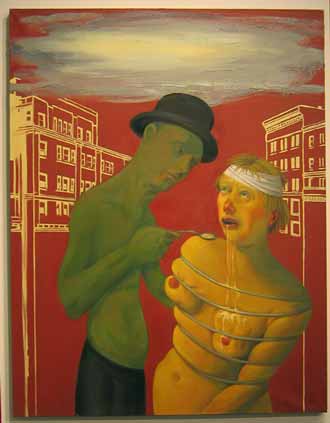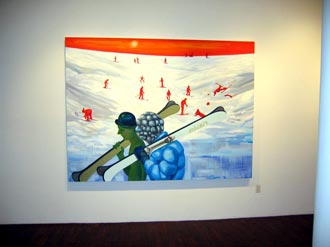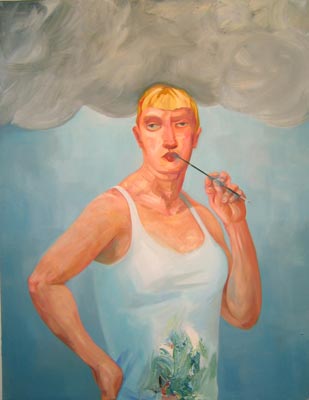Elizaville is a place in the country outside the big city where most of the visible people are males. The landscape, something like where Nicole Eisenman lives in the Hudson Valley, is dominated by them: four boys walking under a clump of tall trees, skiers on a hillside, a burly, nearly naked young farmer, and some rather more ominous and mysterious figures. In fact, there are 40 men and two women. The naked young woman in Commerce Feeding Creativity is bound and being force-fed by a partly naked green man in a bowler hat. The imposing older woman in Inspiration brandishes a long cigarette holder and wears a cloud above her head like a more ethereal hat.
The scenes are lavishly gloomy and morbidly active, like Pieter Breughel the Elder's in the 16th century. Landscapes overwhelm the figures and the figures, with their stolid trudging about and hapless activities, overwhelm the landscapes. 4-20 is Brueghel's The Parable of the Blind, even to the point of a similarity in headgear worn by the four downcast boys in the former and the six stumbling blind men in the latter. European Painting is Brueghel's Huntsmen in the Snow, with the hunters transmogrified into a quilted man and another naked green man in a bowler, and the distant skaters into ill-starred skiers. Inspiration, on the other hand, is Hogarth's The Shrimp Girl, carrying her wares on her head. There are, after all, traditions in western art about how we inhabit the world. The progression of art doesn't only have to do with degrees of realism and abstraction.
Speaking of which, the painting in Eisenman's paintings has an extraordinary presence. The trees that rise high above the four boys in 4-20 are crowned by a cascade of yellow, red, and orange brushstrokes that drip dark rivulets of paint onto the heads of the cartoonishly modeled boys, who seem abject in relationship to the trees, as cartoons inevitably are in relation to the groanings of reality, expressed here in the most abstract of means. The skiers in European Painting are caught as much in the swoops of white paint as they are in the snow, and the red sky of sunset turns them red. In a way, color is crossbred with the role of allegory inherited from the late Medieval-Renaissance times of Brueghel. Figures are signified by their color--for instance, the insinuating badness of the green man and the helplessness of the red figures--and are gripped in veils of blue and white and red brushstrokes, much as Brueghel's are in the details of vast, turbulent landscapes.
They are also gripped by the burden of their caricature. The green man must ignore the flailing skiers and cruelly bind and stuff the naked woman. The boys must submit to their cartoonish forms. The quilted man must withdraw within his quilted garb, and in From Success to Obscurity read a letter that is probably to him rather than from him. Still, there is a sympathy or sense of identification that extends to all of them, to their lost or suffering individuality. Their eyes peer out from within them with some kind of sadness or fear, or perhaps even innocence, within a context that is beyond them--an earth within a larger universe literally in Elizaville Werkstatt--a context that is signified by the ineluctable motions of art. As in Brueghel the characters constantly assume shapes that comport with their roles and the patterns of the worlds in which they live--the seasons, the time of day, the landscape--always trying to exert their individual identities, however strangely they come out. They are pushed forward into our immediate view somewhere near the picture plane, another lesson of modern pictorial space. In Inspiration, there is nothing but the large figure of full-bodied flesh, against a clear blue background, staring directly at the viewer, holding up the cloud like a caryatid, emblazoned with an abstract burst of brushstrokes on her belly.
Donald Goddard © 2004

Commerce Feeding Creativity
4-20, 2004.
Oil on canvas,
96" x 72"

European Painting, 2004.
Oil on canvas,
72" x 96"

Inspiration, 2004.
Oil on canvas,
51" x 39 1/2"